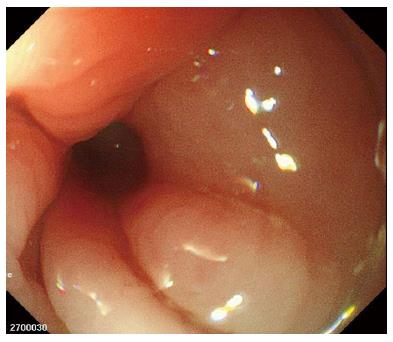Published online Oct 16, 2014. doi: 10.4253/wjge.v6.i10.510
Revised: April 30, 2014
Accepted: September 16, 2014
Published online: October 16, 2014
Processing time: 226 Days and 20.1 Hours
Multiple reports have documented unsuspected inguinal hernias which result in difficulties during the colonoscopic examinations of patients. In most cases, the colonoscopy can be delayed until a surgical consult has further evaluated the inguinal hernia. This case report documents a patient who required a colonoscopy but surgical intervention for the detected inguinal hernia was not appropriate due to his co-morbid medical conditions. With the use of the combination of an enteroscope fitted with a cap and fluoroscopy, the inguinal hernia was able to be negotiated and the diagnosis of a cecal carcinoma was able to be confirmed.
Core tip: Patients with inguinal hernias who are unfit for surgical repair but who have otherwise strong indications for colonoscopy are at risk of failed colonoscopy or an incarcerated colonoscope. This case study demonstrates that the use of a cap fitted to a more flexible enteroscope with fluoroscopic guidance can aid in the negotiation of the scope past the loops of bowel in the hernia sac.
- Citation: Tan VP, Wong IW, Lee YT. Novel use of cap-assisted enteroscopy for detection of colorectal tumor in a patient with incarcerated inguinal hernia. World J Gastrointest Endosc 2014; 6(10): 510-512
- URL: https://www.wjgnet.com/1948-5190/full/v6/i10/510.htm
- DOI: https://dx.doi.org/10.4253/wjge.v6.i10.510
Patients with inguinal hernias are not uncommonly encountered by endoscopists performing colonoscopy. In patients with known large inguinal hernias or complicated inguinal hernias, including incarcerated hernias, surgical repair prior to colonoscopy is clinically indicated. However, in some circumstances, patients are unable to undergo surgical repair despite strong indications for the colonoscopy to be performed persisting. This case report demonstrates a strategy for facilitating the completion of a colonoscopy in such a patient.
A 79-year-old man with a history of severe aortic regurgitation and cardiac failure, presented with anemia and positive fecal occult blood testing. Gastroscopy was normal. A prior colonoscopic examination failed due to poor bowel preparation. He was referred for a second colonoscopy after polyethylene glycol preparation. During colonoscopy a “tight stricture” was encountered at the sigmoid colon. When the patient was turned, a large incarcerated left inguinal hernia was detected. The procedure was repeated with an enteroscope (Olympus SIF-Q260) fitted with a 4-mm cap at the tip, and under fluoroscopic guidance (Figure 1). Finally, with the aid of the cap, the scope negotiated through the acute bend inside the hernia sac and reached the cecum, where a large sessile tumor was found (Figure 2). Biopsies confirmed adenocarcinoma. No complication occurred during or after the procedure. The patient declined surgery due to his co-morbid conditions and died 3 mo later from cardiac causes.
Unexpected hernia detected during or after screening colonoscopy is not uncommon[1-5]. It may cause failure of the colonoscopy procedure[1-3] or result in a surgical emergency due to a colonoscopy induced strangulated bowel loop or incarceration[4,5]. Endoscopists should maintain a high index of suspicion when a “stricture” is seen in association with normal looking mucosa and consider whether a hernia could be a contributing factor. It is easy to detect the presence of inguinal hernia with proper exposure of the patient, however, for other types of hernia, fluoroscopic examination may be required[4,5]. In cases where an inguinal hernia is detected, colonoscopy should be delayed until a surgical opinion is sort however for cases where surgery would be inappropriate and colonoscopy still warranted, the use of fluoroscopic guidance can prevent inadvertent looping during scope passage through the hernia. The use of cap-assisted method, which had been shown to reduce colonoscopy failure rate[6], together with the use of a thin enteroscope contributed to the success of the examination.
A case of a patient with strong indications for a colonoscopy and an incarcerated inguinal hernia whose co-morbid medical conditions preclude surgical repair of the inguinal hernia.
The clinical diagnosis after cap-assisted colonoscopy performed with an enteroscope was cecal adenocarcinoma.
Possible differential diagnoses include bleeding colonic polyp, bleeding colonic angiodysplasia and colonic neoplasms.
Prior to the colonoscopy, the patient had iron deficiency anemia and fecal occult blood testing of his stools were positive.
A large sessile polyp suspicious for a neoplasm was seen in the cecum, which was biopsied and sent for histopathology confirming cecal adenocarcinoma.
The patient declined surgery due to his co-morbid conditions that had precluded surgery for his inguinal hernia in the first place and died 3 mo later from cardiac causes.
Negotiation through loops of bowel incarcerated in a hernia sac utilizing a cap fitted onto an enteroscope has seldom been reported in the literature, and is a useful strategy for endoscopists to consider when a similar circumstance presents itself.
This case reports discusses a case where a patient had strong indications for a colonoscopy despite the presence of an incarcerated inguinal hernia, and presents a strategy utilizing a cap fitted to an enteroscope for facilitating the completion of the colonoscopy to enable the diagnosis of cecal adenocarcinoma to be made.
This paper is helpful for clinical practice.
P- Reviewer: Gao C, Seow-Choen F S- Editor: Ji FF L- Editor: A E- Editor: Zhang DN
| 1. | Tan VP, Lee YT, Poon JT. Incarceration of a colonoscope in an inguinal hernia: Case report and literature review. World J Gastrointest Endosc. 2013;5:304-307. |
| 2. | Leisser A, Delpre G, Kadish U. Colonoscope incarceration: an avoidable event. Gastrointest Endosc. 1990;36:637-638. |
| 4. | Alder AC, Scott DL, Browning JD. Colonoscopy: an unusual complication. Gastroenterology. 2010;138:434, 794. |














